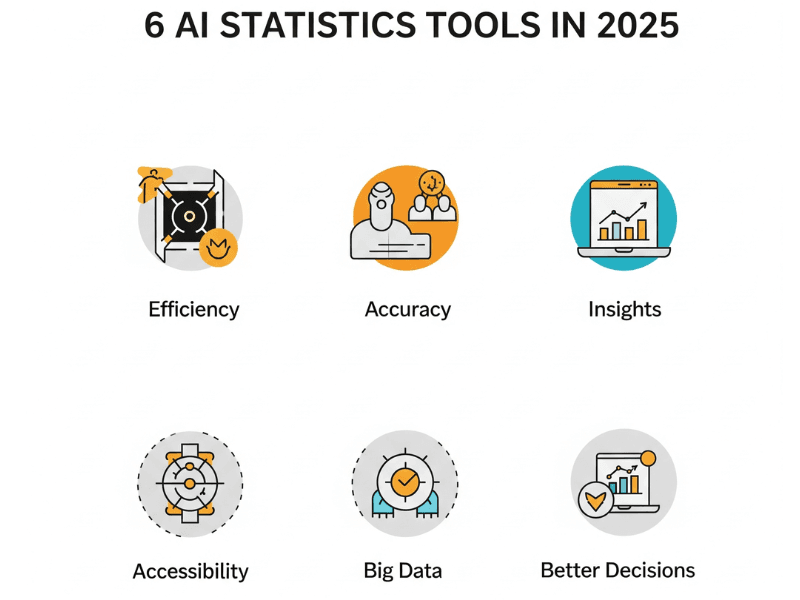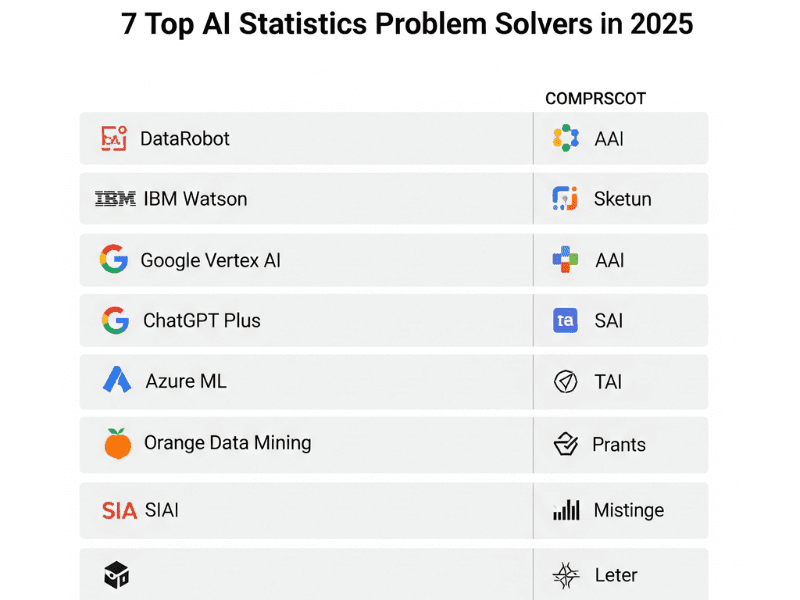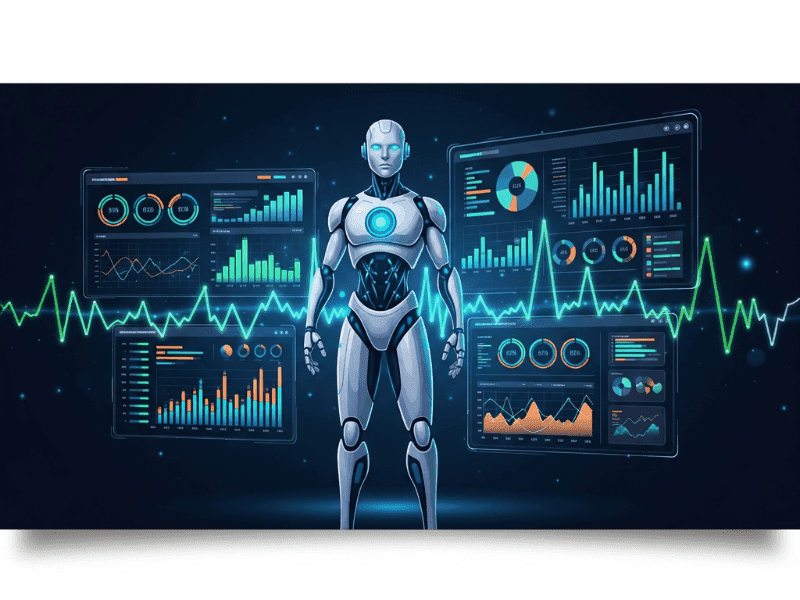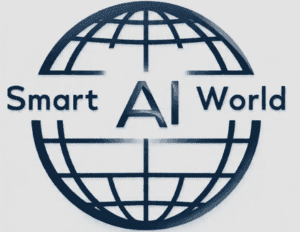Overview
Quick Navigation
Toggle
It is now 2025, and the amount of data being created around the world is mind-boggling. For students struggling with homework and experienced data analysts uncovering hidden truths, the usual ways of solving statistical problems are often too slow, too complicated, or just not good enough. The AI Statistics Problem Solver is here to change the way we work with data.
An AI statistics problem solver is a smart assistant that uses cutting-edge artificial intelligence to comprehend, evaluate, and interpret complicated statistical data. It is more than just a calculator. These advanced technologies offer insights with unmatched speed and accuracy, automate time-consuming computations, and spot patterns that the human eye might overlook. They are now an essential need in our increasingly data-driven world rather than a luxury.
In 2025, why would an AI statistics problem solver be so important? because there has never been a greater need for data analysis that is accurate, timely, and insightful. These AI-powered technologies provide an efficiency and depth of research that human efforts alone frequently cannot match, whether you’re attempting to forecast market trends, validate scientific theories, or just comprehend survey results.
🔍 What Makes an AI Statistics Problem Solver Indispensable?

Fundamentally, an AI Statistics Problem Solver is a program or platform that uses AI technologies, such as deep learning, machine learning, and natural language processing (NLP), to solve statistical problems.
Unlike conventional statistical software, these AI tools can often:
- Understand Natural Language: The AI understands your intent and does out the required statistical calculations when you ask queries in simple English.
- Automate Complex Workflows: Numerous processes can be automated, ranging from preprocessing and data cleaning to selecting the best statistical test and displaying the findings.
- Provide Explanations: A smart AI Statistics Problem Solver can explain why particular findings occurred and what they mean, rather than just spitting out numbers.
- Identify Hidden Patterns: In huge datasets, machine learning models can identify abnormalities and subtle connections that conventional approaches could miss.
✅ The Irresistible Advantages of AI in Statistics for 2025

The widespread adoption of the AI Statistics Problem Solver isn’t just a trend; it’s a paradigm shift driven by tangible benefits:
- Unmatched Efficiency: A task that could take hours or days to do manually can be completed in minutes by AI technologies, which can handle large datasets and carry out complex analysis. In situations that move quickly, this speed is extremely useful.
- Enhanced Accuracy: The possibility of human error is greatly reduced by automating computations and decreasing manual input, producing more trustworthy findings.
- Deeper Insights: Artificial intelligence (AI) algorithms are skilled at identifying subtle patterns and relationships in data, offering deep insights that might lead to wiser choices.
- Democratization of Statistics: User-friendly AI interfaces make advanced statistical approaches accessible to a wider audience, including individuals without extensive statistical knowledge.
- Handling Big Data: Only an AI Statistics Problem Solver can effectively handle and extract meaning from petabytes of data as volumes continue to increase.
- Improved Decision-Making: People and organizations may make better, data-driven decisions if they have quick access to thorough and reliable statistical insights.
📊 Top AI Statistics Problem Solver Tools to Watch in 2025

The market for AI Statistics Problem Solver tools is booming, with innovation happening at a rapid pace. Here’s a look at some of the leading contenders setting the standard in 2025:
- Features: DataRobot is a powerful AI Statistics Problem Solver for intricate predictive analytics since it is an enterprise-grade automated machine learning (AutoML) platform. With features like feature engineering, algorithm selection, and hyperparameter tuning, it automates the creation, deployment, and management of models. It performs exceptionally well in tasks like time series forecasting, regression, and classification.
- Pros: Highly automated, supports a variety of data types, has strong governance and MLOps capabilities, and excels in predictive modeling and large-scale data analysis. It enables data scientists to create reliable models more quickly.
- Pricing: primarily caters to business clients, offering tailored pricing according to features, usage, and support needs. They frequently provide proofs of concept and demos.
- Features: For both structured and unstructured data, Watson Discovery and its analytical modules serve as a potent AI Statistics Problem Solver by utilizing IBM’s impressive AI capabilities. It excels at sentiment analysis, finding patterns in large datasets, and extracting insights from text using natural language processing (NLP). Its cognitive capabilities are intricately linked to its statistical functions.
- Pros: Strong in cognitive analysis and natural language processing, it can handle large volumes of a variety of data, integrate with other IBM cloud services, and has strong security features. It is a complete answer for sophisticated data comprehension.
- Pricing: cloud-based service with tiers of pricing, usually according to consumption (e.g., compute time, data storage, and API calls). For preliminary investigation, free tiers are frequently offered.
- Features: For developers and data scientists, Google Cloud’s Vertex AI is a comprehensive machine learning platform that also functions as a potent AI Statistics Problem Solver. It offers resources for managing datasets, training models (including AutoML ones), assessing models, and deploying them. Its scalability and interaction with Google’s vast cloud environment, which allow for sophisticated statistical modeling at scale, are its main advantages.
- Pros: Strong support for deep learning, strong scalability and robustness, strong integration with Google Cloud services, comprehensive AutoML features, and flexibility for developing bespoke models. It’s the place to go for advanced AI research.
- Pricing: Pay-as-you-go pricing that varies according on the precise AI services used, data storage, and compute utilization. You can find comprehensive price information on the Google Cloud website.
- Features: ChatGPT Plus’s “Advanced Data Analysis” (formerly Code Interpreter) feature turns it into an approachable and user-friendly AI Statistics Problem Solver, even though it is primarily a large language model. In order to conduct statistical studies, create visualizations, find correlations, and even develop Python code snippets for more complicated tasks, users can upload datasets (such as CSV, Excel, etc.) and ask natural language inquiries.
- Pros: The interface is very easy to use, uses natural language, is fast for exploratory data analysis, creates visualizations instantly, and is useful for learning and rapid insights. For many, it’s a simple access point.
- Pricing: A monthly subscription cost is required for ChatGPT Plus. Prices vary by area.
- Features: As a powerful AI Statistics Problem Solver inside the Azure ecosystem, Azure Machine Learning offers a complete environment for creating, honing, and implementing machine learning models. It provides full code development environments (Jupyter Notebooks) as well as low-code/no-code alternatives (like Azure Machine Learning Designer). It easily connects with other Azure services and supports a wide range of statistical models.
- Pros: High scalability, strong connectivity with the Microsoft ecosystem, solid security and compliance features, a full toolset for the ML lifecycle, and flexibility for different skill levels. It serves a broad range of users.
- Pricing: Like other cloud services, consumption-based pricing is based on compute, storage, and the particular machine learning services used. Estimates can be obtained using Azure’s pricing calculator.
- Features: A new platform called SIAI was created especially to solve AI statistics problems. It focuses on automating power analysis, experimental design, and hypothesis testing. Its ability to choose the best statistical test for your data and research issue, then walk you through the interpretation of the results using p-values and confidence intervals, is its unique selling proposition.
- Pros: aims for high statistical rigor, offers thorough result interpretations, helps users choose tests, and is intensely focused on core statistical inference. Perfect for researchers who require accurate statistical findings.
- Pricing: It is anticipated to provide tiers of subscriptions with discounts for academic and research institutions. Early in 2025, a beta program might be accessible.
- Features: Orange is an open-source application for data analysis and visualization that integrates machine learning and artificial intelligence. Its visual programming interface enables users to create intricate statistical workflows, including data preprocessing, feature selection, modeling, and evaluation, even though it is not strictly an AI statistics problem solver. It’s great for teaching and interactive exploration..
- Pros: It is free and open-source, has a visual programming interface (many activities don’t require code), is good at exploring and visualizing data, and has a number of machine learning algorithms. It’s excellent for visual analysis and learning.
- Pricing: Free (open-source).
How AI Statistics Problem Solvers Empower Diverse Professionals

The transformative power of an AI Statistics Problem Solver extends across various professions, significantly boosting efficiency and insight for:
For Students 🧑🎓
For many students, statistics can be a daunting subject. An AI Statistics Problem Solvercan be an invaluable learning companion:
- Concept Reinforcement:It helps students better understand difficult statistical ideas and procedures by offering step-by-step answers to challenges.
- Practice and Exploration:Without becoming mired down in tedious calculations, students can experiment with various datasets and analyses, leading to a more intuitive understanding.
- Error Reduction:Because there are fewer arithmetic errors when calculations are automated, pupils can concentrate on analyzing the findings rather than merely obtaining the correct number.
- Time Savings:Once-hour-long assignments can now be finished more quickly, freeing up time for in-depth research and other academic endeavors.
For Researchers 🔬
Researchers across academia, science, and medicine rely heavily on robust statistical analysis. An AI Statistics Problem Solver streamlines their work:
- Accelerated Analysis: It accelerates the research cycle from data collection to insight creation by processing huge experimental datasets rapidly.
- Optimal Test Selection: In order to ensure methodological rigor, AI can suggest the best statistical tests depending on the kinds of data and research questions.
- Bias Detection: Potential biases or confounding variables in data that might otherwise go overlooked can be found with the aid of certain AI tools.
- Enhanced Discovery: AI can generate novel theories and discoveries by identifying minute patterns that human analysis might overlook.
- Reproducibility: A crucial component of maintaining scientific integrity is the repeatability of research findings, which can be enhanced with the use of automated workflows.
For Data Analysts & Scientists 📊
Data analysts and scientists are on the front lines of data interpretation. An AI Statistics Problem Solver elevates their capabilities:
Supercharged Productivity: It frees up analysts to concentrate on higher-value tasks by automating repetitive processes like data transformation, cleaning, and preliminary statistical summaries.
Advanced Modeling: Without requiring a lot of coding, analysts may rapidly test out a variety of intricate statistical models (such as advanced regression, time series, and multivariate analysis).
Insight Generation: AI facilitates the quick identification of important patterns, irregularities, and connections that influence marketing plans, corporate choices, and operational enhancements.
Improved Communication: Complex statistical findings are easier to explain to stakeholders who are not technical thanks to a variety of tools that help create engaging data representations.
Predictive Power: An AI Statistics Problem Solver with powerful machine learning skills may create incredibly accurate predictive models, giving forecasters a competitive advantage.
The Road Ahead: The Evolving Role of AI in Statistics
The current capabilities of the AI Statistics Problem Solver are just the beginning. Looking ahead, we can anticipate even more sophisticated integrations and features:
- Prescriptive Analytics: AI may begin suggesting courses of action based on statistical results in addition to problem-solving.
- Ethical AI in Statistics: A stronger focus on explainable AI (XAI) will guarantee statistical results are transparent and less biased.
- Seamless Integration: Existing research platforms, business intelligence dashboards, and instructional resources will further integrate AI Statistics Problem Solvers.
- Adaptive Learning: User comments may help future products improve their statistical explanations and recommendations.
Conclusion: Embracing the Future with AI Statistics Problem Solvers ✅

By 2025, the AI Statistics Problem Solver is a crucial, game-changing technology rather than a sci-fi idea. These clever tools are changing how we think about statistics, from making difficult calculations easier for students to revealing profound insights for academics and speeding up analysis for data professionals.
The benefits are obvious: more accessibility to potent analytical methods, deeper insights, improved accuracy, and hitherto unheard-of efficiency. People and organizations can confidently traverse the ever-more-complex world of data, make better decisions, and open up new opportunities by utilizing an AI Statistics Problem Solver. Adopting these cutting-edge AI assistants is essential for leading the way in the intelligent era of data analysis, not just for staying up.
Frequently Asked Questions (FAQ)
❓ What is the core function of an AI Statistics Problem Solver?
The primary purpose of an AI statistics problem solver is to automate and streamline the statistical analysis process through the use of machine learning and artificial intelligence technologies. It can evaluate data, find patterns, and carry out intricate computations—often with the help of an intuitive interface that can comprehend queries in normal language. Compared to manual approaches, this enables consumers obtain accurate statistical insights much more quickly.
❓ How can students use an AI Statistics Problem Solver to improve their studies?
An AI statistics problem solver is a useful teaching and practice tool for students. It can offer detailed answers to homework issues, concise explanations of statistical topics, and assistance in visualizing data to simplify difficult concepts. A learner can gain a greater understanding of the subject by concentrating more on the reasoning and interpretation of statistical results when the laborious computations are automated.
❓ Is an AI Statistics Problem Solver suitable for a professional data analyst or researcher?
Yes, without a doubt. An AI Statistics Problem Solver can greatly increase accuracy and productivity for a professional researcher or data analyst. In addition to recommending the best statistical models and handling large datasets that would take a lot of time to evaluate manually, the program can automate data cleaning and preprocessing. Instead of becoming mired down in tedious statistical activities, professionals may concentrate on strategic insights and storytelling by using a powerful AI Statistics Problem Solver.
❓ How does an AI Statistics Problem Solver handle complex statistical tests like regression or hypothesis testing?
An excellent AI statistics program Regression and hypothesis testing are examples of difficult tests that Problem Solver manages by automating the entire procedure. Users only need to provide their data and formulate their study topic in simple terms. After choosing the proper test and conducting the analysis, the AI will produce a comprehensive output that contains the results, p-values, confidence intervals, and an understandable explanation of the significance of the findings. This improves the efficiency and accessibility of advanced statistical inference.
❓ Can I trust the results generated by an AI Statistics Problem Solver?
Because they are based on well-established statistical methods, the findings produced by a respectable AI Statistics Problem Solver are typically very trustworthy. Nonetheless, the caliber of the input data always affects the caliber of the output. An experiment with bad design or faulty data cannot be corrected by AI. In order to make sure they are asking the right questions and interpreting the results accurately, a user should still have a basic understanding of the statistical process even though the tool offers powerful analysis.

Pingback: 🚀 Generative AI Certificate Google: All You Need to Know (2025) - Smart AI World
Pingback: 7 Best AI Market Research Tools to Try in 2025